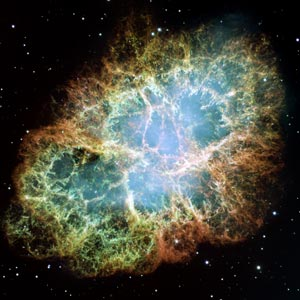Fermi's Large Area Telescope Sees Surprising Flares in Crab Nebula
Menlo Park, Calif.—The Crab Nebula, one of our best-known and most stable neighbors in the winter sky, is shocking scientists with its propensity for fireworks—gamma-ray flares set off by the most
 |
| Fermi's Large Area Telescope has recently detected two short-duration gamma-ray pulses coming from the Crab Nebula, which was previously believed to emit radiation at very steady rate. The pulses were fueled by the most energetic particles ever traced to a discrete astronomical object. (Image courtesy NASA/ESA.) |
"We were dumbfounded," said Roger Blandford, who directs the Kavli Institute for Particle Astrophysics and Cosmology, jointly located at the Department of Energy's SLAC National Accelerator Laboratory and Stanford University. "It's an emblematic object," he said. The Crab Nebula, also known as M1, was the first astronomical object catalogued in 1771 by Charles Messier. "It's a big deal historically," Blandford continued, "and we're making an amazing discovery about it."
Blandford was part of a KIPAC team led by scientists Rolf Buehler and Stefan Funk that used observations from the Large Area Telescope, one of two primary instruments aboard NASA's Fermi Gamma-ray Space Telescope, to confirm one flare and discover another. Their report was posted online today in Science Express alongside a report from the Italian orbiting telescope Astro-rivelatore Gamma a Immagini LEggero, or AGILE, which also detected gamma-ray flares in the Crab Nebula.
The Crab Nebula, and the rapidly spinning neutron star that powers it, are the remnants of a supernova explosion documented by Chinese and Middle Eastern astronomers in 1054. After shedding much of its outer gases and dust, the dying star collapsed into a pulsar, a super-dense, rapidly spinning ball of neutrons. The Crab Nebula's pulsar emits a pulse of radiation every 33 milliseconds, like clockwork.
Though it's only 10 miles across, the amount of energy the pulsar releases is enormous, lighting up the Crab Nebula until it shines 75,000 times more brightly than the sun. Most of this energy is contained in a particle wind of energetic electrons and positrons traveling close to the speed of light. These electrons and positrons interact with magnetic fields and low-energy photons to produce the famous glowing tendrils of dust and gas Messier mistook for a comet over 200 years ago.
The particles are even forceful enough to produce the gamma rays the LAT normally observes during its regular surveys of the sky. But those particles did not cause the dramatic flares.
Each of the two flares the LAT observed lasted a few days before the Crab Nebula's gamma-ray output returned to more normal levels. According to Funk, the short duration of the flares points to synchrotron radiation, or radiation emitted by electrons accelerating in the magnetic field of the nebula, as the cause. And not just any accelerated electrons: the flares were caused by super-charged electrons of up to 1015 electron volts, or 10 quadrillion electron volts, approximately 1,000 times more energetic than the protons accelerated by the Large Hadron Collider in Europe, the world's most powerful man-made particle accelerator, and more than 15 orders of magnitude greater than photons of visible light.
"The strength of the gamma-ray flares shows us they were emitted by the highest-energy particles we can associate with any discrete astrophysical object," Funk said.
Not only are the electrons surprisingly energetic, added Buehler, but, "the fact that the intensity is varying so rapidly means the acceleration has to happen extremely fast." This challenges current theories about the way cosmic particles are accelerated. These theories cannot easily account for the extreme energies of the electrons or the speed with which they're accelerated.
The discovery of the Crab Nebula's gamma-ray flares raises one obvious question: how can the nebula do that? Obvious question, but no obvious answers. The KIPAC scientists all agree they need a closer look at higher resolutions and in a variety of wavelengths before they can make any definitive statements. The next time the Crab Nebula flares, the Fermi LAT team will not be the only team gathering data. They'll need all the help they can get to decipher the mysteries of the Crab Nebula
"We thought we knew the essential ingredients of the Crab Nebula," Funk said, "but that's no longer true. It's still surprising us."
Source: SLAC website